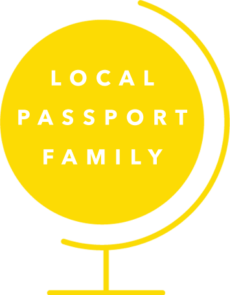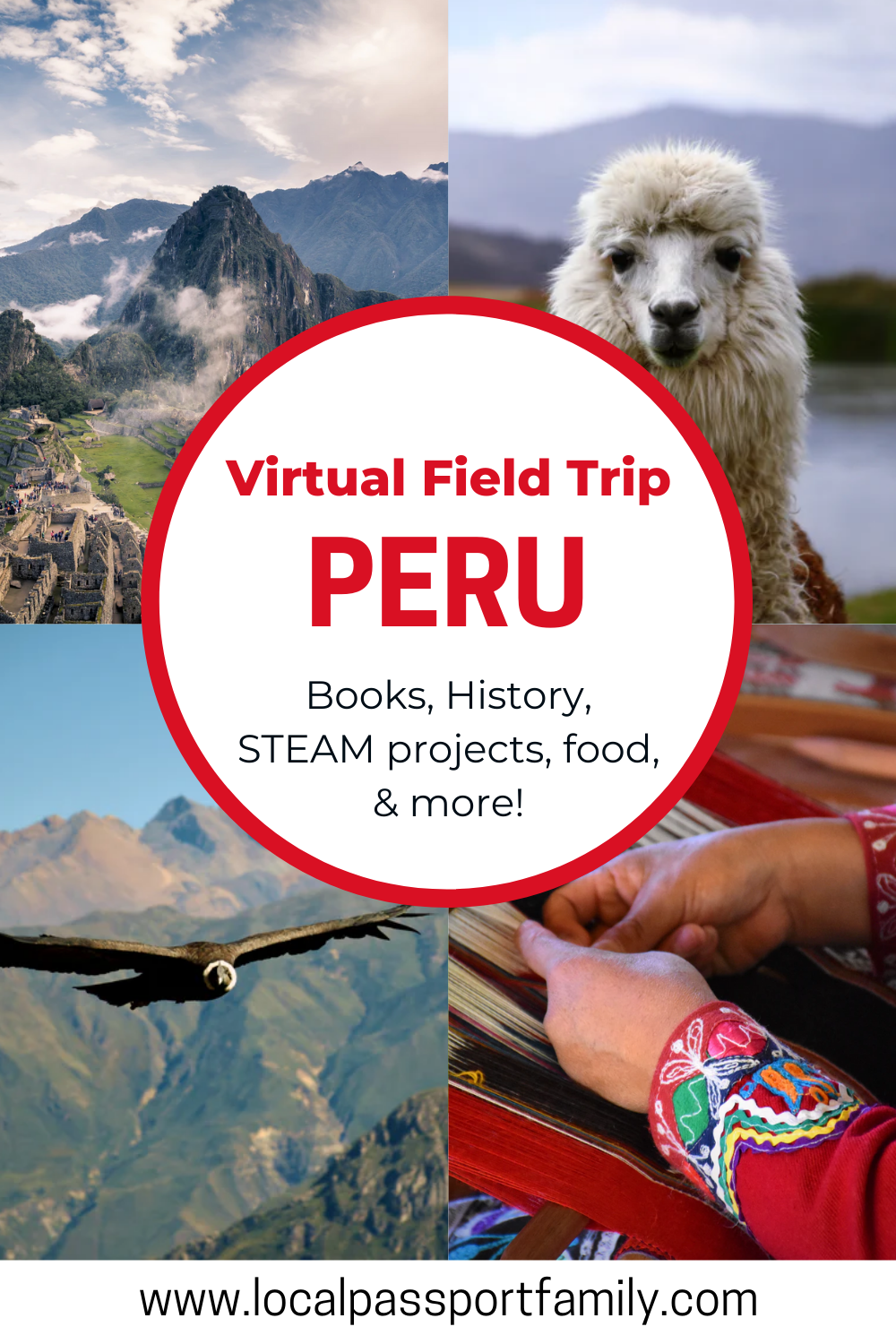Welcome to P is for Peru for the Global Children’s Book Club! Today we’ll be going on a virtual tour of Peru with kids. Get ready for a fun and inspiring Peru virtual field trip – perfect for global education at home or for a Peru homeschooling unit.
You can find the full list of countries for the book club right HERE. Be sure to sign up for the email list to get all the information in advance and to receive fun extras!
Get your FREE Alphabet Printable Passport here!
Here’s the 2020 Global Children’s Book Club discussion schedule!
This Peru virtual tour contains affiliate links, but all opinions are 100% my own. That means I earn a small commission if you purchase through my link, but doesn’t change your price.
P is for Peru: Peru Virtual Tour for Kids
Featured Peru Book
Kusikiy A Child from Taquile, Peru by Mercedes Cecilia (Author, Illustrator)
Author Read Aloud

Kusikiy A Child from Taquile, Peru Picture Book Discussion Questions
Other Peru Books for Kids
Peru Facts
- The capital of Peru is Lima.
- The official name is Congreso de la República del Perú (the Congress of the Republic of Peru).
- Martín Vizcarra is the current President of Peru.
- Peru is located on the western coast of South America.
- Peru borders 5 countries – Chile, Bolivia, Brazil, Colombia, and Ecuador.
- Spanish is one of the main languages of Peru, and is the most popular language (spoken by about 82% of the population). There are a number of indigenous languages, as well, the most popular of which is Quechua, followed by Aymara.
- The currency in Peru is the sol. $1 USD ~ 3.5 Peruvian sol.
- Peru generally has two seasons – wet and dry – although it varies greatly from coastal areas to high mountainous areas.
- About 85-90% of Peruvians identify as Roman Catholic.
- The primary industries in Peru are mining, manufacturing, and tourism.
- Peru grows over 3,000 kinds of potatoes and 55 kinds of corn.
- The Sechura Desert in southern Peru has the highest sand dune in the world.
- The Giant Andean Condor in Peru is the biggest flying bird on earth.
- Lake Titicaca is the world’s highest lake (that can be accessed).
- The Amazon River starts in Peru.
- You can tell if a Native Quechua woman is married or single by her hat (married women wear straw hats, while single women wear knitted hats).
- 75% of the world’s alpacas live in Peru.
- Weaving is very important in ancient Peruvian culture.
Color in Peru on this map of South America!

Peru with Kids: Flag Activity
The Peru flag has two red vertical stripes with a white stripe in the middle. Depending on the use, it may have one of several emblems in the middle.


Flag from HERE
HERE is a fun printable Peru flag coloring sheet!
Peru Virtual Tour to a Featured Landmark
Machu Picchu
The Inca Empire was the largest empire in pre-Columbian America. High up in the Andes Mountains in Peru, they built the fortification of Machu Picchu. It has spectacular views and is especially well-known for the sophisticated building style and materials. It was also aligned with the stars in multiple ways. Quite a bit of Machu Picchu has been restored and renovated to give a better idea of what it would have been like at its height.


Featured Peruvian Artist: Susana Baca
Susana Baca is a Peruvian musician who helped bring Afro-Peruvian music back to prominence. She grew up in a fishing village outside Lima, and uses many indigenous Peruvian instruments in her music. Her music is a blend of modern and folk styles, and helped include Afro-Peruvian culture as an important part of mainstream Peruvian culture.
Susana has won two Latin Grammy awards, and was also named the Minister of Culture for Peru in 2011.

Featured Important Peruvian Person: St. Martin de Porres
St. Martin de Porres was part of the Dominican Order in the Catholic church. He was the son of a formerly enslaved woman of Afro-Peruvian descent and a Spanish nobleman, who later abandoned the family. His family was very poor, and then he was sent off to school when his mother could not take care of him. He was not allowed to become a full member of the Order as he was of mixed race, but continued to serve and volunteer generously. Eventually, he was allowed to take religious vows, though it was not officially allowed.
When an epidemic was happening in Lima, he began bringing the sick to the convent. He performed many miracles in their care, including appearing through locked doors. His superior forbade him from doing so because he was afraid of spreading the sickness, so St. Martin began taking them to his sister’s house as a hospice. One day, he found an Indian who was bleeding to death from a dagger wound and took him to his own room until he could go to his sister’s house. When his superior reprimanded him, he said, “Forgive my error, and please instruct me, for I did not know that the precept of obedience took precedence over that of charity.” The prior then let him continue to help people who were sick.
St. Martin provided for many through alms. He helped and served people regardless of race or status, and founded an orphanage and a children’s hospital, using his medical training. He is also the patron saint of mixed-race people and those who are working for racial harmony.
Featured Peruvian Food: Peruvian Recipes for Kids
Ceviche is one of Peru’s most popular foods, and also its national dish. To make it, Peruvians mix seafood and combine it with lemon or lime juice and seasonings. Here’s a recipe for Peruvian ceviche. If you’re wary of using raw fish, you could try this vegetarian ceviche with cauliflower!
Potatoes are also popular in Peru, especially the purple variety. Here’s a recipe for huancaina-style potatoes.
Or you could try lomo saltado, a Peruvian stir-fried beef!
If you’re looking for a simple Peruvian snack, you can try making chifles (fried plantain or banana chips), or try to find some Inca Kola!
Peruvian Craft & Culture Activity for Kids: Inca Quipu Project
Peruvian Pan Pipes Craft for Kids
Pan-pipes are an ancient and deeply-rooted instrument in the Peruvian Andes Mountains. We’ll be making an antara, a one-rowed pan pipe (instead of the double-rowed zampona). (Learn more about pan pipes here.)
Materials
- Drinking straws
- Tape
- Scissors
- Ruler
- Pen or pencil
- Colored yarn (optional)
- Take 10 drinking straws and cut them to lengths of 26cm, 24cm, 22cm, 20cm, 18cm, 16cm, 14cm, 12cm, 10cm, and 6cm.
- Line them up in order of length, and tape across the top and bottom where they meet to hold them all together. Make sure you line up all the straws along one edge to create a pan flute formation.
- Take colored yarn and tie around the pan flute to decorate. Attach a long piece of yarn to either side to create a strap.
- Blow across the top to create sound. The longer straws should make a deeper sound, and the shorter ones a higher sound.
Peruvian Quipu Craft
The Incas were great communicators, and used books to record their thoughts. But the Incas didn’t use paper and a pencil to leave a record. Instead, they used yarn, and tied knots to communicate different ideas! They may have recorded legends and records. Learn more about a quipu here.
Materials
Here are the instructions for making your own quipu!

Peruvian Art Books
Other Peru Kids Activities
- This book has 15 incredible projects about the Incas, and here are even more Inca crafts for kids!
- Alpaca farm craft
- Learn a Quechua song for kids!
Animals in Peru


Peru Movement Activities
Paleta Fronton
Paleta fronton is the national sport of Peru. Players use a paddle and a black rubber ball, and play against a wall. There are lines to divide players’ sides, similar to in tennis.

Peruvian Folk Dance

Kid Movies About Peru
Peru Conversations with a Local: Culture, History, & Food Discussion Video
Peru with Kids Discussion Questions
- What is the difference between a llama and an alpaca?
- Spanish became widely used in Peru after Spanish colonists arrived. Do you think that was a good or bad choice (instead of using an indigenous language)?
- If you were to come up with your own instrument using materials commonly found around your home, what would it look like?
- Quechua women wear different types of hat depending on their marital status. Does your culture have any outward symbols of marriage?
- Why do you think the Incas built Machu Picchu in the location they did?
Thanks for Taking a Virtual Visit to Peru With Us!
We’ve loved putting together this resource to virtually visit Peru. We’d love to hear if you do any of these activities for a homeschooling Peru unit, or if you visit in person!
We hope to inspire curiosity and connection through exploring and learning, and we hope this guide helps you and your families. Please share any activities you do with us over on our Instagram. And we’d be delighted if you passed this Peru for kids virtual tour and homeschooling resource along to others, as well!
MORE POSTS
IF YOU LIKED THIS POST ABOUT PERU FOR KIDS, YOU MIGHT LIKE THESE POSTS TOO:
NOT READY FOR A PERU HOMESCHOOLING UNIT QUITE YET? PIN THIS POST FOR LATER!











